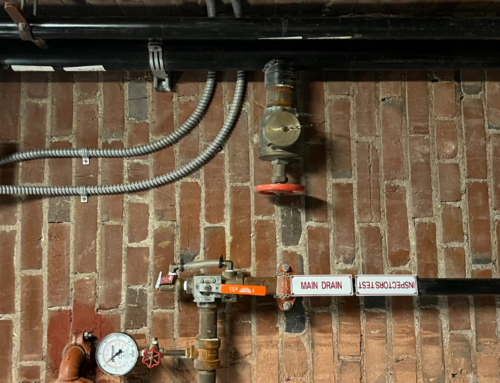The Case of the Missing IAQ Test Data and Rating Standards
How can our HVAC systems be arranged and operated to keep our indoor environment safe and of good quality for everyday life?

You have heard and read a lot over the past nine months about IAQ and the coronavirus. Much of this information has been valuable, and much of it has not. I am not a doctor and will not claim to be an expert in anything. I only have 40 years of industry experience and request your help for additional information, testing, and standards toward improving classification and recommendations for IAQ, both for an “acceptable” level and for a recommended improvement to current recommendations.

Figure 1: The term “biohazard” is defined as “those infectious agents presenting a risk or potential risk to the well-being of man, either directly through his infection or indirectly through disruption of his environment.”

Figure 2: Suffocation happens when something heavy covers the face or chest and prevents a person from breathing. It also occurs when a person is in a place where oxygen runs out, such as a closed-in, airtight space.
IAQ encompasses such factors as maintenance of acceptable temperature and relative humidity, control of airborne contaminants, and distribution of adequate ventilation air.
The U.S. Environmental Protection Agency (EPA) estimates that poor IAQ affects 33%-50% of all commercial buildings in the U.S. and is responsible for more than 125 million lost school days and 10 million lost workdays each year.1
Approximately 3.8 million people around the world die every year as a result of indoor air pollution.2
“Exposure to disinfectants strongly linked to respiratory problems equivalent to smoking a pack [of cigarettes] a day for 10-20 years.”3
Prior to the pandemic, chemical disinfectants had been linked to health problems, but the accelerated pace at which these toxic chemicals are now being used is causing unprecedented levels of exposure with unknown consequences to human health.3
This article will explore enhancements to building air systems that have been noted to improve IAQ.
Surprisingly, many systems, including particulate filtration and gas phase adsorption, exist. However, there is still an absence of test data and rating standards for these systems as well as some potential misinformation that causes concern for their use. ASHRAE’s position document on filtration states that scientific data addressing the effects of these many air cleaners on health are sparse and inconclusive.

Figure 3: An air-handling unit arrangement with MERV-13 recommended filters.
Are we really affecting peoples’ health? A recent report from a local school district reported that a cumulative total of 1,101 students and staff, out of a total of about 18,000, had quarantined due to close contact with a positive case. Of those 1,101 precautionary quarantines, only nine close contacts later tested positive for COVID-19, and it is suspected that six of the nine contracted the virus as a result of contacts with relatives or events outside of the school. Not bad results for a pandemic semester.
Facility staff members are cleaning a lot and spending a great deal of money sanitizing facilities. Are these sanitizing agents safe for our occupants?
How can our HVAC systems be arranged and operated to keep our indoor environment safe and of good quality for everyday life? Ventilation can only be effective in diluting airborne contaminants or virus-containing particles. Natural ventilation in the St. Louis area is not practical, as outdoor air temperatures and humidity levels, in addition to relatively low wind speeds, make the indoor environment unacceptable when trying to rely on natural ventilation. Particulate filtration can only remove particles, and, potentially, contaminants bound to those particles from the airstream that passes through the filters. Gas phase filtration must be utilized in addition to particulate filtration and can only adsorb or chemically react with gases in the airstream that passes through them. Can we do more? Are there other options we should be considering?
ULTRAVIOLET LIGHT
Ultraviolet (UV) light has been mentioned as UV filtration in some articles; however, it does not filter. UV does an effective job of breaking down some contaminants that are exposed to the light output, whether in an airstream or in a room. UV-C is said to inactivate COVID-19 and other bacteria or viruses (pathogenic microorganisms) with a dose or fluence rate of 40 mJ/cm2 to assure at least 4 log inactivation. Most UV lamps are made from a form of quartz that contains impurities that absorb the 185 nm emission entirely so that they do not produce ozone. The further from the UV source, the lower the fluence and less effective the UV is. If the UV can’t reach the microorganism, it cannot inactivate it. I am not certain of any potential health effects of using UV to clean airstreams. I am aware that UV can impact chemicals, but much research is still needed to determine any potential impact. Important research findings from a Brazilian project has centered on the role that PM10 plays in the development of skin cancer, having a delayed effect, which means that clinical diagnoses are often made seven to 14 years after the initial exposure to such substances.4,5 The delayed effect makes any research especially difficult, and although UV does not filter the particulate, it may modify the chemicals that are contained on the particulate or airborne.
In my opinion, UV is particularly effective in keeping HVAC unit cooling coils and drain pans clean, thereby maintaining high-quality air is delivered to the occupied space. UV can be used in a building space; however, precautions must be made so as not to expose occupants to the UV light. UV light can be used to ‘sanitize’ a hospital room in as little as 15 minutes. One of the continuous positive airway pressure (CPAP) cleaning machines uses UV to clean the components, but the process may take multiple cycles with components flipped in between to effectively clean the components. It may leave a burnt smell on equipment and is not recommended for CPAP tubes or nasal pillows. It requires a 5-minute cleaning cycle.7

Figure 4: A table charting UVC’s germicidal effectivemness.
OZONE
My CPAP cleaner and another brand uses ozone to clean components of bacteria, mold, and viruses. Activated oxygen, also known as ozone (O3), is a safe disinfecting agent (at least according to its proponents). Activated oxygen has a short life cycle. After being generated, it automatically decomposes back to oxygen within two hours. My CPAP cleaning unit has a one-hour cleaning cycle and has a clean smell after use.7 This smell is sometimes compared to the fresh smell before a rain shower.
Ozone is also used to control water taste, odor, and color and is a more powerful oxidizing agent than chlorine, but, unlike chlorine, it does not lead to the formation of tri-halomethanes (THMs) or complex chlorinated compounds, which are believed to cause cancer. Ozonated pool water does not cause dry skin or eye irritation nor does it bleach hair. Ozone is a powerful oxidant to decompose organic compounds, such as urine, amino acid, cosmetics, and perspiration. Ozone will decompose within 20 minutes so that there are no over dosage problems. Excess ozone decomposes to oxygen and thus poses no health risk for the fish or the people who subsequently consume them.
Ozone can also be used for air systems and, under certain operating conditions, can be converted to hydroxyl radicals, which are even more powerful oxidizers than ozone itself. Phenol gases are the invisible parts of tobacco smoke that cause discomfort to eyes and create offensive odors. Ozone oxidizes the phenol gases and eliminates the irritations they cause. Ozone rids any environment of the effects of smoke completely rather than merely filtering out the visible particles.
In 1998, McClure Engineering designed an HVAC system in a brewhouse taste room and installed an ozone air purification unit to remove background odors. Odor control for the brewhouse facility was a challenging undertaking. The taste in odor “contaminant” comes from volatile organic compounds (VOCs). The concentration and exact chemical makeup of VOCs is not known. Airborne oxidation by injection of ozone into the air-handler systems was installed to break down the volatile organic compounds into carbon dioxide and water vapor. Space concentration of ozone is maintained between 0.02-0.03 parts per million. The range of the monitor used for controlling this has a range of 0.02-0.1 parts per million. Sustained exposure to concentration greater than 0.1 parts per million is required for any noticeable minor effect on persons. Concentration of control and operation are an order of magnitude below this threshold.8
ELECTRONIC AIR CLEANERS
Electronic air cleaners, air ionizers, bi-polar ionization, cold plasma generator, needlepoint ionization, electrostatic precipitation, etc., are often lumped together under the “electronic air cleaner” classification; however, each of these devices functions and operates differently. It is my opinion that these devices must be broken down into multiple categories: polarized plate precipitators, air ionizers, and high-voltage DC with high-frequency AC grid assembly.
Some of these systems have big claims but may fall short on performance due in part to a lack of standardized testing and rating methods. Since each system may operate by different means, a common standard may not be possible. Groups, such as ASHRAE, normally are first to develop and publish a standard; however, in ASHRAE’s latest position document on filtration and air cleaning, the society has not fully addressed the issue and merely states that, “The data on the health consequences of electronic particle air cleaners are sparse, but it is reasonable to expect that electronic air cleaners affect health similarly to mechanical filters of equivalent particle removal performance.”
Particularly difficult is the fact that these devices may be effective in reducing contaminants throughout the space, not by capturing or filtering contaminants but rather by affecting their molecular make up throughout the space. They also cause particles to agglomerate or gather and fall out of suspension quicker than they would without their presence or allow the larger particles to more easily be transported back to the HVAC particulate filters where the particles are removed.
UL 867, “Standard for Electrostatic Air Cleaners,” includes a test for measuring the production of ozone but is primarily for quality control and safety of the electrical components. It does nothing to rate the effectiveness or efficiency of the air cleaner.
Embedded Video: https://youtu.be/Gpr34KSn3Dc
The processes and effectiveness of the methods behind these types of air devices are not new. Corona discharge ionization systems have been operating since the late 1800s. We have seen the effectiveness of similar applications in industry. Electroplating is the process of plating one metal onto another by hydrolysis — most commonly for decorative purposes or to prevent corrosion of a metal. There are also specific types of electroplating, such as copper, silver, and chromium plating. Powder coating is a type of coating that is applied as a free-flowing, dry powder. Unlike conventional liquid paint, which is delivered via an evaporating solvent, powder coating is typically applied electrostatically and then cured under heat or with UV light. The electrostatic charge causes the paint powder particles to adhere evenly over all surfaces. So, since we can use these as part of our process work, can we also apply these principals to buildings?
The challenge is that buildings are different with different sizes and types of HVAC systems. It is difficult to develop test methods that adequately represent a “standard” building. Also challenging is the fact that delayed health effects may not be known for up to 15 years.
Oxygen has an electron volt potential of 12.07eV. When the power input is greater than 12.07eV, ozone is created due to oxygen being ionized or “activated.” Every gas in the atmosphere has an electron volt potential, including Xylene 7.89eV, Styrene 8.46eV, Methyl Ethyl Ketone 9.52eV, Ammonia 10.07eV, Ethyl Alcohol 10.48eV, and Formaldehyde 10.88eV. Nice information to know but not practical in the field. You grab the molecules, and I’ll grab my Fluke.
NEEDLEPOINT BI-POLAR IONIZATION
Needlepoint bi-polar ionization (NPBI) has been used for particle reduction, odor control, pathogen control, energy savings, and static electricity control for more than 10 years.
Ions produced by NPBI are also attracted to pathogens, and when the ions combine on the surface of a pathogen, they rob the pathogen of the hydrogen necessary for it to survive. During the final step of deactivation, the ions eliminate hydrogen from the pathogen, making the airborne virus, bacteria, or mold spore inactive or non-viable.
I happen to have a small ionization without a fan installed in an outlet near our cat litter box and can certainly attest to its ability to improve our indoor environment.
The Association of Home Appliance Manufacturers (AHAM) developed the procedure ANSI/AHAM AC-1, “Method for Measuring Performance of Portable Household Electric Cord-Connected Room Air Cleaners,” to rate portable cleaners by measure of clean air delivery rate (CADR). CADR is the cfm of air in a 1,008-cubic-foot (28.5 m3) room that has had all particles of a given size distribution removed from the air, over and above the rate at which the particles are naturally falling out of the air. The method of rating was originally developed in the 1980s, and the latest version is dated 2020. The rating only applies to particulate matter, not to gases. The rating system uses defined particle size ranges of 0.09-1.0 µm for smoke, 0.5-3 µm for dust, and 5-11 µm for pollen and is only valid for rooms up to 8 feet (2.4 m) in height. It does not appear to give any consideration to UV, ozone, or ionization.
WHAT MEASUREMENTS ARE NEEDED FOR IAQ VERIFICATION?
The Well Building Standard Version 2, 2018 International WELL Building Institute, suggests we monitor the following IAQ parameters:
PM2.5 less than 15 µg/m3 (St. Louis outdoor has a 2016 PM2.5 of 9 µg/m3); and
PM10 less than 50 µg/m3 (St. Louis outdoor has a 2016 PM10 of 18 µg/m3).
Individual component VOCs less than or equal to the limits listed below for 19 components:
- Benzene 30 µg/m3 (0.03 ppm);
- Carbon disulfide 400 µg/m3;
- Carbon tetrachloride 20 µg/m3;
- Chlorobenzene 500 µg/m3;
- Chloroform 150 µg/m3;
- Dichlorobenzene (1,4-) 400 µg/m3;
- Dichloroethylene (1,1) 35 µg/m3;
- Ethylbenzene 1000 µg/m3;
- Hexane (n-) 3500 µg/m3;
- Isopropyl alcohol 3500 µg/m3;
- Methyl chloroform 500 µg/m3;
- Methylene chloride 200 µg/m3;
- Methyl tert-butyl ether 4000 µg/m3;
- Styrene 450 µg/m3;
- Tetrachloroethene 17.5 µg/m3;
- Toluene 150 µg/m3;
- Trichloroethylene 300 µg/m3;
- Vinyl acetate 100 µg/m3;
- Xylene (m, o, p combined) 350 µg/m3;
- In commercial kitchens, formaldehyde must be less than 81 ppb; and
- Inorganic gases of carbon monoxide less than 9 ppm (30 ppm in kitchens) and ozone less than 51 ppb.
In looking only at benzene, the Occupational Safety and Health Administration (OSHA) defines a permissible exposure limit (PEL) of 1 ppm (measured as a time weighted average [TWA]). The National Institute for Occupational Safety and Health’s (NIOSH’s) recommended exposure limit (REL) is 0.1 ppm TWA. Germany’s TRGS 910 defines tolerable exposure at 0.006 ppm, while the odor threshold is 0.78 ppm. I also note that I cannot purchase a Dräger short-term sampling tube with less than a 0.25- to 2-ppm range, and it has cross sensitivities to toluene, xylene, and ethyl benzole. How, then, are we to measure all of the contaminants listed above? Note that also for some contaminants, the measurement zone is near the floor, some are near the breathing zone, and some are near the ceiling. Ionization counts, polarity of materials, or other electrical measures are not mentioned or considered in the Well Building Standard. The standard only looks at 19 VOCs, while microbial volatile organic compounds (MVOCs) are volatile organic compounds that can be produced by microorganisms in their primary or secondary metabolism. In total, around 1,200 MVOCs have been identified and around 250 MVOCs from mold have been measured in indoor environmental studies. It might also be noted that the European Union uses the boiling point rather than volatility in its definition of VOCs. The EPA formerly defined the regulated organic compounds in outdoor air as reactive organic gases (ROGs). This terminology clarified its meaning as being limited to reactive chemicals; however, the EPA later changed that terminology to VOC.
Unfortunately, the use of the term VOC rather than ROG has created a misunderstanding when applied to IAQ. Many individuals and organizations, including manufacturers of building materials and products and third party certification organizations, have come to think of VOCs as “only those regulated by EPA for outdoor air” and apply the same definition for indoor air purposes.9
With Europe defining some things differently than the U.S., with OSHA, NIOSH, EPA, and TRGS 910 all defining exposure limits differently, it is no wonder I remain confused. Also having difficulty finding instrumentation to easily and economically measure the WELL recommended list of contaminants of concern, I find it challenging to comply or verify the recently written standard.
Particulate filtration plus combinations of UVC and HV-HF systems together will produce the best IAQ within buildings.
Displacement ventilation may also be worth considering instead of normal mixing airflows, but that is another article that maybe Kishor Khankari or Raj Setty can write. (Both have significant contributions to our industry).
ASHRAE 2020-2021 president Chuck Gulledge III has set his theme for the society year as “The ASHRAE Digital Lighthouse and Industry 4.0.”
Knowledge needs to be captured and linked in such a way that all relevant stakeholders benefit. Doing so requires an understanding of how to collect, store, and analyze data so that it is insightful and actionable. We have a lot of understanding to do in order to make IAQ measurements, means, and methods relevant and beneficial to all stakeholders.
FOOTNOTES:
1. U.S. Environmental Protection Agency, Indoor Air Quality for Schools Program, www.epa.gov/iaq-schools, and W.J. Fisk, “Estimates of Potential Nationwide Productivity and Health Benefits from Better Indoor Environments: An Update,” in J. Spengler (ed.) Indoor Air Quality Handbook (New York, McGraw-Hill, 2001.)
3. The Epoch Times, September 30-October 6, 2020, “Covid Disinfectants May Be Hazardous to Humans”
4. “The impact of atmospheric particulate matter on cancer incidence and mortality in the city of São Paulo, Brazil.” Yanagi Y, Assunção JV, Barrozo LV, Cad Saude Publica. 2012 Sep; 28(9):1737-48.
6. mrsa-uv.com
7. https://www.thecpapshop.com/blog/lumin-vs-sleep8-a-user-review/
8. http://www.triozone.us/portal/
9. https://www.epa.gov/indoor-air-quality-iaq/technical-overview-volatile-organic-compo

Chuck Dale-Derks, P.E.
Published November 23, 2020 in Engineered Systems
Chuck Dale-Derks, P.E., is a principal at McClure Engineering, a mechanical and electrical consulting engineering firm dedicated to the development of innovative solutions to unique engineering problems.



